Lockheed F-104 Starfighter
| F-104 Starfighter | |
|---|---|

| |
| Royal Netherlands Air Force F-104G Starfighter in flight, 1963 | |
| Role | |
| National origin | United States |
| Manufacturer | Lockheed |
| First flight | 4 March 1954 (XF-104)[1] |
| Introduction | 20 February 1958 (United States) |
| Retired | 1969 (USAF) 1975 (US ANG) 1972 (Pakistan Air Force) 1997 (Taiwanese Air Force) 31 October 2004 (Italy) |
| Status | Retired from military service; in use with civilian operators as warbirds |
| Primary users | United States Air Force German Air Force Turkish Air Force Italian Air Force |
| Number built | 2,578 |
| Developed from | Lockheed XF-104 Starfighter |
| Variants | Lockheed NF-104A Canadair CF-104 Starfighter Aeritalia F-104S Starfighter |
| Developed into | Lockheed CL-1200 Lancer/X-27 Lockheed CL-288 |
The Lockheed F-104 Starfighter is an American single-engine,
After a series of interviews with
While its time with the USAF was brief, the Starfighter found much more lasting success with other NATO and allied nations. In October 1958, West Germany selected the F-104 as its primary fighter aircraft. Canada soon followed, along with the Netherlands, Belgium, Japan, and Italy. The European nations formed a construction consortium that was the largest international manufacturing program in history to that point, though the Starfighter's export success was marred in 1975 by the discovery of bribe payments made by Lockheed to many foreign military and political figures for securing purchase contracts.
The Starfighter eventually flew with fifteen air forces, but its poor safety record, especially in
The Starfighter featured a radical design, with thin, stubby wings attached farther back on the fuselage than most contemporary aircraft. The wing provided excellent supersonic and high-speed, low-altitude performance, but also poor turning capability and high landing speeds. It was the first production aircraft to achieve Mach 2, and the first aircraft to reach an altitude of 100,000 ft (30,000 m) after taking off under its own power. The Starfighter established world records for airspeed, altitude, and time-to-climb in 1958, becoming the first aircraft to hold all three simultaneously. It was also the first aircraft to be equipped with the M61 Vulcan autocannon.
Development
Background and early development
Clarence L. "Kelly" Johnson, vice president of engineering and research at Lockheed's Skunk Works, visited USAF air bases across South Korea in November 1951 to speak with fighter pilots about what they wanted and needed in a fighter aircraft.[2][3] At the time, the American pilots were confronting the MiG-15 with North American F-86 Sabres, and many felt that the MiGs were superior to the larger and more complex American fighters. The pilots requested a small and simple aircraft with excellent performance, especially high-speed and high-altitude capabilities.[4] Johnson started the design of such an aircraft upon his return to the United States. In March 1952, his team was assembled; they studied over 100 aircraft configurations,[5] ranging from small designs at just 8,000 lb (3,600 kg),[6] to large ones up to 50,000 lb (23,000 kg).[7] To achieve the desired performance, Lockheed chose a small and simple aircraft, weighing in at 12,000 lb (5,400 kg) with a single powerful engine. The engine chosen was the new General Electric J79 turbojet, an engine of dramatically improved performance in comparison with contemporary designs.[8] The small design powered by a single J79, issued Temporary Design Number L-246, remained essentially identical to the prototype Starfighter as eventually delivered. Lockheed designated the prototype Model 083.[9]
Johnson presented his new fighter concept to the United States Air Force on 5 November 1952, and they were interested enough to create a general operational requirement for a lightweight fighter to supplement and ultimately replace the yet-to-fly
Work progressed quickly, with a mock-up ready for inspection at the end of April,
Though development of the F-104 was never a secret, only a vague description of the aircraft was given when the USAF first revealed its existence. No photographs of the aircraft were released to the public until 1956, even though the XF-104 first flew in 1954. At the April 1956 public unveiling of the YF-104A, the engine inlets were obscured with metal covers. Visible weapons, including the M61 Vulcan cannon, were also hidden.[15][16] Despite the secrecy, an artist's rendering of the yet-unseen F-104 appeared in the September 1954 edition of Popular Mechanics that was very close to the actual design.[17]
The prototype made a hop into the air during taxi trials on 28 February 1954 and flew about five feet (1.5 m) off the ground for a short distance, but this was not counted as a first flight. On 4 March, Lockheed test pilot Tony LeVier flew the XF-104 for its first official flight. He was airborne for only 21 minutes, much shorter than planned, due to landing gear retraction problems.[18][19] The second prototype was destroyed several weeks later during gun-firing trials when the hatch to the ejector seat blew out, depressurizing the cockpit and causing the pilot to eject in the mistaken belief that a cannon mishap had crippled the aircraft.[20] Nevertheless, on 1 November 1955 the remaining XF-104 was accepted by the USAF.[21]
Further development
Based on the testing and evaluation of the XF-104, the next variant, the YF-104A, was lengthened and fitted with a General Electric J79 engine, modified landing gear, and modified air intakes.[22] The YF-104A and subsequent models were 5 ft 6 in (1.68 m) longer than the XF-104 to accommodate the larger GE J79 engine. The YF-104 initially flew with the GE XJ79-GE-3 turbojet which generated 9,300 pounds of dry thrust (14,800 with afterburner), which was later replaced by the J79-GE-3A with an improved afterburner.[23]
Seventeen YF-104As were ordered by the USAF on 30 March 1955 for further flight testing.[24] The first of them flew on 17 February 1956 and, with the other 16 trial aircraft, was soon carrying out aircraft and equipment evaluation and tests. On 1 May 1957 one of the prototypes was destroyed when the ailerons malfunctioned, resulting in the aircraft tumbling wildly. The pilot ejected safely.[25] Lockheed made several improvements to the YF-104A throughout this testing period, including strengthening the airframe, adding a ventral fin to improve directional stability at supersonic speed, and installing a boundary layer control system (BLCS) to reduce landing speed.[23]
Problems were encountered with the J79 afterburner; further delays were caused by the need to add AIM-9 Sidewinder air-to-air missiles. On 28 January 1958, the first production F-104A to enter service was delivered to the 83rd Fighter Interceptor Wing.[26]
Redesign for NATO
In response to a 1957 German Air Staff Paper asking for a single aircraft to fulfill its fighter, fighter-bomber, and reconnaissance mission requirements,[27] Lockheed redesigned the entire airframe, including 96 new forgings, additional skin panels, and reinforced landing gear with larger tires and improved brakes. The proposed F-104G (for Germany) "Super Starfighter" featured a more powerful J79-11A engine, a larger tail with powered rudder (the same used on the two-seat F-104B and D), improved blown flaps with a mode for improved maneuverability, electric de-icing equipment for the air intake inlets, and a larger drag chute. Avionics were improved as well, primarily with the Autonetics F15A NASARR (North American Search and Range Radar) multi-mode radar and the LN-3 inertial navigation system by Litton Industries, the first such system to be placed into operational service. Altogether, these changes increased the amount of external weapons that could be carried to 3,000 lb (1,400 kg), and also allowed the aircraft to fulfill the NATO requirement of carrying a 2,000 lb (910 kg) "special store" (nuclear weapon) under the fuselage.[28]
Belgium, the Netherlands, and Italy selected the F-104 soon after as well, and the four European nations set up four production groups to jointly manufacture the F-104G under license. Arbeitsgemeinschaft (ARGE) South consisted of
The multinational consortium formed a central coordination office named NASMO (NATO Starfighter Management Office) in
In all, 2,578 F-104s were produced by Lockheed and under license by various foreign manufacturers.[34]
Design
Airframe
The Starfighter's airframe was all-metal, primarily duralumin with some stainless steel and titanium.[35] The fuselage was approximately two and a half times as long as the airplane's wingspan. The wings were centered on the horizontal reference plane, or along the longitudinal centerline of the fuselage, and were located substantially farther aft on the fuselage than most contemporary designs. The aft fuselage was elevated from the horizontal reference plane, resulting a "lifted" tail, and the nose was "drooped". This caused the aircraft to fly nose up, helping to minimize drag. As a result, the pitot tube, air inlet scoops, and engine thrust line were all canted slightly from centerline of the fuselage.[36]
The F-104 featured a radical wing design. Most jet fighters of the period used a

The new wing design was extremely thin, with a thickness-to-
The small, highly loaded wing caused an unacceptably high landing speed, even after adding both leading- and trailing-edge
| External videos | |
|---|---|
The
The fuselage had a high
Engine
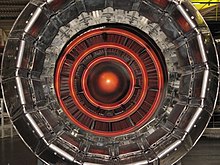
The F-104 was designed to use the General Electric J79 turbojet engine,
The engine consisted of a 17-stage compressor, an accessory drive section, an annular combustion chamber, a three-stage turbine, and an afterburner. The most powerful version of the J79, the J79-GE-19, was rated at 52.8 kN (11,900 lbf) dry thrust and 79.6 kN (17,900 lbf) with afterburner. Bleed air from the compressor's 17th stage was used for a number of purposes: the BLCS, cabin pressurization and air conditioning, hot-air jet rain removal, fuel transfer, canopy and windshield defogging and defrosting, pressure for the pilot's anti-G suit, pressurization and cooling of the nose-mounted radar equipment, and purging of gas from the M61 autocannon. The accessory drive ran two hydraulic pumps, two variable-frequency generators, the generator for the tachometer, and pumps for engine fuel and oil.[49][50]
Armament
The basic armament of the F-104 was the 20 mm (0.79 in) M61 Vulcan autocannon. As the first aircraft to carry the weapon, testing of the Starfighter revealed issues with the initial version of the M61: the
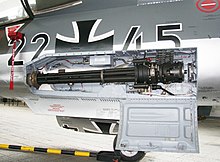
The cannon, mounted in the lower part of the port fuselage, was fed by a 725-round drum behind the pilot's seat. With its firing rate of 6,000 rounds per minute, the cannon would empty the drum after just over seven seconds of continuous fire.[52] The cannon was omitted in all the two-seat models and some single-seat versions including reconnaissance aircraft, with the gun bay and ammunition drum typically replaced by additional fuel tanks.[53]
Two AIM-9 Sidewinder air-to-air missiles could be carried on the wingtip stations, which could also be used for fuel tanks. The F-104C and later models added a centerline pylon and two underwing pylons for bombs, rocket pods, or fuel tanks; the centerline pylon could carry a nuclear weapon.[52] A "catamaran" launcher for two additional Sidewinders could be fitted under the forward fuselage, although the installation had minimal ground clearance and so rendered the seeker heads of the missiles vulnerable to ground debris. The two F-104S variants added a pair of fuselage pylons beneath the intakes for conventional bomb carriage and an additional pylon under each wing, for a total of nine.[54]
Early Starfighters were also capable of carrying and launching a single
Avionics

The initial USAF Starfighters had a basic RCA AN/ASG-14T1 ranging radar,
In the late 1960s, Lockheed developed a more advanced version of the Starfighter, the F-104S, for use by the Italian Air Force. Similarly to the F-104G, Lockheed produced two main variants of the F-104S: an all-weather interceptor (caccia intercettore, CI) and a strike aircraft (caccia bombardiere, CB). The CI variant received a FIAR/NASARR F15G radar with AIM-7 Sparrow guidance capability; however, the new missile-guidance avionics came at the expense of the M61A1 Vulcan cannon, which was removed to make room. The CB variant was equipped with a FIAR/NASARR R21G-H radar and a radar altimeter for low-level strike missions, retaining the cannon as its only air-to-air weapon.[57]
As part of the Aggiornamento Sistema d'Arma (ASA), or "Weapons System Upgrade" in the mid-1980s, both variants were given an ALQ-70/72 ECM and a FIAR/NASARR R-21G/M1 radar with
Ejection seat

Early Starfighters used a downward-firing ejection seat (the Stanley C-1), out of concern over the ability of an upward-firing seat to clear the "T-tail" empennage. This presented obvious problems in low-altitude escapes, and 21 USAF pilots, including test pilot Captain Iven Carl Kincheloe Jr., failed to escape from their stricken aircraft in low-level emergencies because of it. The downward-firing seat was replaced by the Lockheed C-2 upward-firing seat, which was capable of clearing the tail, but still had a minimum speed limitation of 90 kn (104 mph; 167 km/h).[59] Many export Starfighters were later retrofitted with Martin-Baker Mk.7 "zero-zero" (zero altitude and zero airspeed) ejection seats.[60]
Production assembly
The Starfighter was designed for production rates of up to 20 airplanes per day from a single assembly line. The entire aircraft was designed for modular assembly and disassembly. The two principal fuselage sections were split along the vertical centerline and completely assembled in two separate halves. All equipment, including wiring and plumbing, were installed inside the two-halves before being joined. The wings were then attached with ten bolts plus a fairing.[61]
Operational history
U.S. Air Force
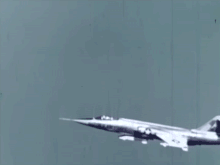
Although the F-104 was designed as an
The newly operational aircraft experienced problems with both the J79 engine and M61 cannon, and after three months of service, the unit was grounded following a series of engine-related accidents. The aircraft were then fitted with the J79-GE-3B engine and another three ADC units were equipped with the F-104A. During this time, the Air Force's interest in the Starfighter was waning due to a shift in strategy toward fighters with longer ranges and heavier ordnance loads.[62] As a result, the USAF reduced their orders of the F-104A from 722 to 170,[63] and the F-104A and F-104B aircraft of the 83rd, 56th and 337th FIS were handed over to the 151st, 157th and 197th FIS of the Air National Guard (ANG) after less than a year of service with the ADC.[64]
Taiwan Strait Crisis of 1958
In August 1958, only a few months after establishing operational readiness with the F-104, the 83rd FIS was assigned to an air defense and deterrence mission in Taiwan after the
On 10 September, the first F-104s arrived in Taiwan, delivered disassembled by
Berlin Crisis of 1961

During the Berlin Crisis of 1961, President
Vietnam War
The F-104C entered service with USAF
From the first F-104 deployment in April 1965 to December, Starfighters flew a total of 2,937 combat sorties. These sorties resulted in the loss of five aircraft, one from the 476th TFS, which deployed from April to July 1965,
Starfighters returned to Vietnam when the 435th Tactical Fighter Squadron re-deployed from June 1966 until August 1967.[77] During this time F-104s flew a further 2,269 combat sorties, for a total of 5,206.[82] F-104s operating in Vietnam were upgraded in service with AN/APR-25/26 radar warning receiver equipment.[83] One such example is on display in the Air Zoo in Kalamazoo, Michigan.[84] During the second deployment, an additional nine aircraft were lost for a total of 14 F-104s lost to all causes in Vietnam. In July 1967, the Starfighter units transitioned to the McDonnell Douglas F-4 Phantom II.[77][85]
In 1967, these TAC aircraft were transferred to the Air National Guard.[86]
| Date | Model | Unit | Cause of loss/remarks |
|---|---|---|---|
| 29 Jun 1965 | F-104C | 476th TFS
|
Shot down by enemy ground fire while providing close air support (CAS).[87] |
| 22 Jul 1965 | F-104C | 436th TFS
|
Downed by ground fire while on a CAS mission.[88] |
| 20 Sep 1965 | F-104C | 436th TFS | Downed by MIGCAP mission.[81]
|
| 20 Sep 1965 | F-104C F-104C |
436th TFS | Mid-air collision while conducting air search for earlier PLAN-downed F-104C.[81] |
| 1 Aug 1966 | F-104C | 435th TFS
|
Downed by SA-2 surface-to-air missile (SAM) while on Operation Iron Hand escort mission.[89]
|
| 1 Aug 1966 | F-104C | 435th TFS
|
Downed by SA-2 SAM while on Iron Hand escort mission.[89] |
| 1 Sep 1966 | F-104C | 435th TFS | Downed by anti-aircraft artillery fire (AAA) while on armed reconnaissance mission.[90] |
| 2 Oct 1966 | F-104C | 435th TFS | Downed by SA-2 SAM at 10,000 feet while on armed reconnaissance mission.[91] |
| 20 Oct 1966 | F-104C | 435th TFS | Downed by ground fire during armed reconnaissance mission.[92] |
| 12 Jan 1967 | F-104C | 435th TFS | Operational loss; crashed while landing after a CAP mission.[93] |
| 16 Jan 1967 | F-104C | 435th TFS | Operational loss; engine failure during a CAP mission.[94] |
| 28 Jan 1967 | F-104C | 435th TFS | Operational loss; engine failure during a CAP mission.[95] |
| 14 May 1967 | F-104C | 435th TFS | Operational loss; engine failure during armed reconnaissance mission.[82] |
North American service
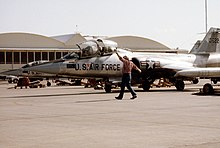
By the late 1950s, USAF fighter doctrine had shifted away from air superiority (fighter against fighter combat) and placed more importance on the interceptor (fighter against bomber combat) and tactical fighter-bomber roles. The F-104 was deemed inadequate for either, lacking both payload capability and endurance in comparison with other USAF aircraft. As a result, the USAF procured only 296 examples of the Starfighter, including both single-seat and two-seat versions. The F-104's service with the USAF was quickly wound down after the aircraft's second deployment to southeast Asia in 1967.
The last use of the F-104 Starfighter in US markings was training pilots for the
Pakistan Air Force

In 1961, Pakistan, as a
The PAF also provided F-104 instructors to Jordan in order to train their pilots on the aircraft after the Royal Jordanian Air Force started receiving its Starfighters in 1968. One of the Jordanian pilots, Major Ihsan Shurdom, later rose to command the RJAF.[102]

The Starfighter served with the
Rann of Kutch Conflict
During the
An F-104 flown by Farooq Umar also assisted the Army's 24th Cavalry, 15th Frontier Force and 15th Punjab regiments in capturing "Biar Bet" from Indian forces.[103][104][105]

Later in June, PAF F-104s forced an Indian Dassault Ouragan which had intruded into Pakistani airspace to make a forced landing at Jangshahi Village near Badin.[101]
Indo-Pakistani war of 1965
PAF F-104s were deployed in a variety of roles during the 1965 war. These included
In the opening rounds of the war on 1 September,
On 3 September 1965, two Griffin F-104As flown by Flying Officer Abbas Mirza and
The F-104s first Air to Air combat victory was achieved by the
On 7 September 1965, a Griffin F-104A flown by Flight Lt. Amjad Hussein Khan intercepted 6 Indian
On 11 September 1965, a Griffin F-104A flown by
On 13 September 1965,
On 21 September 1965,
In total, Griffin F-104s flew 246 hours and 45 minutes during the 1965 war, 204 day
Indo-Pakistani War of 1971
The commencement of hostilities in 1971 led to PAF deploying its small fleet of F-104s heavily in Air to Air and Ground Attack roles. Surplus F-104As and F-104Bs were also received from Jordan.[111][102]
- Ground Attack
In early December 1971, PAF launched
On 3 December 1971, a formation of two Starfighters attacked the IAF Radar station at Amritsar.[113]
On 4 December 1971, Squadron leaders Amanullah and Rashid Bhatti flying F-104As again struck the IAF's Amritsar radar without any significant results due to heavy Anti-Aircraft fire.[100]
On 11 December, two F-104As piloted by Wing Commander Arif Iqbal Squadron Leader M. Amanullah struck the Indian airbase of
- Air to Air Combat
On 4 December 1971, a Folland Gnat and Sukhoi Su-7 were shot down after they confronted a formation of two PAF Starfighters attacking the Amritsar Radar.[100][115]
On 8 December, an F-104 piloted by Flight Lieutenant Manzoor Bokhari intercepted a
On 10 December, an F-104 flown by Wing Commander Arif Iqbal shot down an Indian Navy Bréguet 1050 Alizé while attacking the Okha Port.[100]
On the morning of 12 December, the first direct air-to-air combat engagement between an F-104 and a
The second F-104 loss occurred several days later on 17 December when a pair of
1967 Taiwan Strait Conflict
On 13 January 1967, four ROCAF F-104G aircraft engaged a formation of J-6/MiG-19s of the People's Liberation Army Air Force over the disputed island of Kinmen (Quemoy). Major Hu Shih-lin and Captain Shih Bei-puo each shot down one MiG-19. One F-104 did not return to base and its pilot was listed as missing in action.[122][123]
F-104 designer Kelly Johnson stated that this particular battle illustrated the relative strengths and weaknesses of the Starfighter in aerial combat. "We had them on acceleration and we had them on steady-state altitude, but we could not turn with them," said Johnson, who at the time was working on the larger-winged, more-maneuverable
Other international service

At the same time that the F-104 was falling out of U.S. favor, the West German Air Force was looking for a multi-role combat aircraft to operate in support of a missile defense system.
The Starfighter found a new market with other NATO countries as well, and eventually more than 2,000 of all variants of the F-104 were built for international air forces.[128] Several countries received their aircraft under the U.S. government-funded Military Aid Program (MAP).[129] The American engine was retained but built under license in Europe, Canada, and Japan.[130] The Lockheed ejector seats were retained initially but were replaced in some countries by the safer Martin-Baker seat.[33]
The so-called "Deal of the Century" produced substantial income for Lockheed, but the resulting
In the Netherlands, the F-104 was used to aid in the ending of the 1977 Dutch train hijacking. On 11 June 1977, almost three weeks after the start of a hijacking of a train by Moluccan separatists, six F-104 jet fighters of the Royal Netherlands Air Force overflew the train three times at low altitude, using their afterburners to disorient the hijackers as a precursor to an armed attack by Dutch marines. None of the Starfighters used its weapons.
The international service of the F-104 began to wind down in the late 1970s, being replaced in many cases by the General Dynamics F-16 Fighting Falcon, but it remained in service with some air forces for another two decades. The last operational Starfighters served with the Italian Air Force, which retired them on 31 October 2004.[133]
NASA

The Starfighter served with
In August 1956, the USAF transferred YF-104A serial number 55–2961 to the
An F-104B, originally USAF 57-1303 later received civil registry as N819NA, NASA 819. It became the longest-serving NASA F-104 in both calendar time (1958–1978) and flight hours. Its credits include being the first aircraft in history to perform manned testing of a ballute at supersonic speed. It was also the first to test piloted landings of vehicles such as the X-15 and lifting bodies with the pilot using only stereo periscopic vision. It was used extensively for biomedical research, evaluation of new full pressure suits, and general utility duties for NASA research. One notable case was its service as the final chase plane for the official FAI world altitude record flight of the #3 X-15.[citation needed]
Between August and October 1963, Lockheed delivered three single-seat F-104G Starfighters to NASA, designated F-104N, for use as high-speed chase aircraft. These were the only Starfighters built by Lockheed specifically for NASA; all other NASA aircraft were transferred from the USAF. The third of these F-104Ns, number 013, was destroyed on 8 June 1966 in a mid-air collision with a
One NASA F-104G, registration N826NA, was equipped with a flight test fixture (FTF) consisting of a pylon mounted on the fuselage centerline. The FTF contained instruments to record and transmit research data in real-time to engineers in mission control at Dryden. One application of the FTF was testing heat-resistant tiles for use on the Space Shuttle, ensuring their bonding was sufficient at high speeds and evaluating their performance when exposed to moisture. The last of these missions flew on 31 January 1994, bringing the F-104's service with NASA to a close after more than 18,000 flights.[134]
Use as space launch platform
In 2011, 4Frontiers Corporation and Starfighters Inc (a private F-104 operator) began working together on a project to launch suborbital sounding rockets from F-104s flying out of Kennedy Space Center. First launches were expected to occur in 2012.[135][136] In early 2016, another venture, CubeCab, was working on a rocket system that would launch CubeSats from F-104s.[137][138][139] The company said it planned to begin providing launch services "in early 2020".[140][needs update]
Flying characteristics
The Starfighter was the first combat aircraft capable of sustained Mach 2 flight, and its speed and climb performance remained impressive more than thirty years after its first flight.[141] Equipped with razor-edge thin-blade supersonic wings (visible from the cockpit only in the mirrors),[142] it was designed for optimum performance above Mach 1.2.[143] If used appropriately, with high-speed surprise attacks and good use of its exceptional thrust-to-weight ratio, it could be a formidable opponent.[144] It was exceptionally stable at high speed, i.e., over 600 knots (1,100 km/h; 690 mph), at very low level, making it a potent tactical nuclear strike-fighter. However, in a low-speed turning contest with conventional subsonic opponents (as Pakistani pilots were with Indian Mystères in 1965),[145] the fighter was vulnerable.[146] The F-104's large turn radius was due to the high speeds required for maneuvering, and its high-alpha stalling and pitch-up behavior required attentiveness from its pilot.[147] In reference to the F-104's low-speed turn performance, a humorous colloquialism was coined by a pilot in the skies over Edwards Air Force Base: "Banking with intent to turn."[148]
Early problems
The F-104 series all had a very high

Another serious design issue that the aircraft encountered was T-tail flutter. Dick Heppe, who served as the initial project aerodynamics engineer for the F-104 program, recalled that "without question, the single most difficult technical challenge encountered in the XF-104 and F-104A development programs was the catastrophic flutter problem of the unique T-tailed empennage configuration". Because the horizontal tail's center of gravity was well aft of both the bending and torsional axes of the vertical tail to which it was attached, it was highly vulnerable to flutter at transonic speeds. During a test flight of the F-104A, the surviving XF-104 was flying chase to observe, and encountered violent T-tail flutter that caused the tail to separate from the aircraft. The test pilot of the XF-104 successfully ejected. This behavior was remedied by increasing the thickness of the stainless-steel box covers used in the tail assembly.[153]
The J79 was a brand-new engine, with development continuing throughout the YF-104A test phase and during service with the F-104A. The engine featured variable-incidence compressor stator blades, a design feature that altered the angle of the stator blades automatically with altitude and temperature.[13] A condition known as "T-2 reset", a normal function that made large stator blade angle changes, caused several engine failures on takeoff. It was discovered that large and sudden temperature changes (e.g., from being parked in the sun prior to becoming airborne) were falsely causing the engine stator blades to close and choke the compressor. The dangers presented by these engine failures were compounded by the downward ejection seat, which gave the pilot little chance of a safe exit at low level. The engine systems were subsequently modified and the ejection seat changed to the more conventional upward type.[154][155]
Uncontrolled oscillations of its wingtip-mounted fuel tank sheared one wing off of an F-104B; this problem was apparent during testing of the XF-104 prototype and was eventually resolved by filling the tank compartments in a specific order.[156]
Early F-104s also lacked modulated afterburning, and as a result combat operations could only be performed at one of only two settings – either maximum military power or full afterburner. Effectively this gave the pilot the choice of two level-flight speeds: Mach 1 or Mach 2.2.[157]
Later problems
A further engine problem was that of uncommanded opening of the variable-thrust nozzle (usually through loss of engine oil pressure, as the nozzles were actuated using engine oil as hydraulic fluid); although the engine would be running normally at high power, the opening of the nozzle resulted in a drastic loss of thrust to below that required to maintain level flight. At low altitudes this was unrecoverable, and it caused the loss of at least seven F-104s during testing. A modification program installed a manual nozzle closure control that reduced the problem, but according to designer Kelly Johnson, this took nine years to resolve satisfactorily.[158][157]
The engine also suffered from afterburner blowout on takeoff, or even non-ignition, resulting in a major loss of thrust that could be detected by the pilot—the recommended action was to abandon the takeoff. The first fatal accident in German service was caused by this phenomenon. Some pilots experienced uncommanded "stick kicker" activation at low altitudes while flying straight and level, so F-104 crews were often directed to deactivate it for flight operations.[159] Asymmetric or "split" flap deployment was another frequent cause of accidents.[160] Many pilots also experienced severe nose wheel "shimmy" on landing, which usually resulted in the aircraft leaving the runway and in some cases even flipping over onto its back.[161]
West German service
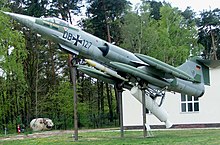
The introduction of a highly technical aircraft type to a newly reformed air force was fraught with problems. Many pilots and ground crew had settled into civilian jobs after World War II and had not kept pace with developments, with pilots being sent on short "refresher" courses in slow and benign-handling
One contributing factor to this was the operational assignment of the F-104 in West German service: it was mainly used as a low-level fighter-bomber, as opposed to the original design of a high-speed, high-altitude fighter/interceptor. Furthermore, the installation of additional avionic equipment in the F-104G version, such as the inertial navigation system, added distraction for the pilot, as well as extra weight that further hampered the flying capabilities of the plane. In contemporary West German magazine articles highlighting the Starfighter safety problems, the aircraft was portrayed as "overburdened" with technology, which was considered a latent overstrain on the aircrews.[163]
In 1966
Eric Brown described the Starfighter as a hot ship, that "has to be flown every inch of the way". The USAF required Starfighter pilots to have at least 1,500 flight hours of experience prior to flying the F-104. West German pilots had around 400 hours.[167] Brown recommended the Blackburn Buccaneer instead.
Normal operating hazards

The causes of a large number of aircraft losses were the same as for any other similar type. They included: bird strikes and other foreign object damage (particularly to the engine), lightning strikes, pilot spatial disorientation, and mid-air collisions with other aircraft.[168] One such accident occurred on 19 June 1962 when a formation of four F-104F aircraft, practicing for the type's introduction-into-service ceremony the following day, crashed together after descending through a cloud bank. The pilot of the lead aircraft lost spatial orientation and was at too steep a nose-down angle to recover. Three German pilots and one American pilot were killed, and the four aircraft destroyed. As a result, formation aerobatic teams were immediately banned by the Luftwaffe.[169]
Safety record
The safety record of the F-104 Starfighter became high-profile news in the mid-1960s, especially in West Germany.[170] West Germany initially ordered 309 F-104s, and over time another 607.[171] Deliveries of Lockheed-built aircraft started in August 1961, and domestically produced airframes began to roll off the assembly lines in December.[32] That same month, the first of an eventual total of 292 West German F-104s had crashed.[172] In October 1975, Lockheed agreed to pay a total of 3 million Deutsche Marks (US$1.2 million) to approximately 60 widows and dependents of 32 Luftwaffe pilots killed during flight operations, though the company declined to admit liability.[173] While announcing the settlement, the plaintiffs' attorney acknowledged he had been seeking US$10 million and noted that there were more instances of pilot error than he had expected.[174]

Some operators lost a large proportion of their aircraft through accidents, although the accident rate varied widely depending on the user and operating conditions. The German Air Force and Federal German Navy, the largest combined user of the F-104 and operator of over 35% of all airframes built, lost approximately 32% of its Starfighters in accidents over the aircraft's 31-year career.
The cumulative destroyed rate of the F-104 Starfighter in USAF service as of 31 December 1983 was 25.2 aircraft destroyed per 100,000 flight hours. This is the highest accident rate of any of the USAF Century Series fighters. By comparison, the cumulative destroyed rates for the other Century Series aircraft in USAF service over the same time period were 16.2 for the North American F-100 Super Sabre, 9.7 for the McDonnell F-101 Voodoo, 15.6 for the Republic F-105 Thunderchief, and 7.3 for the Convair F-106 Delta Dart.[183] By comparison, the Royal Australian Air Force (RAAF) experienced an overall loss rate of 11.96 per 100,000 flying hours with the Dassault Mirage III, losing 40 of 116 aircraft to accidents over its 25-year career from 1965 to 1989.[184][185] The Royal Air Force lost over 50 of 280 English Electric Lightnings, at one point experiencing 12 losses in the 17 months between January 1970 and May 1971; the loss rate per 100,000 hours from the introduction of the Lightning in 1961 to May 1971 was 17.3, higher than the lifetime West German Starfighter loss rate of 15.08.[186]
Notable USAF pilots who died in F-104 accidents include
World records
The F-104 was the first aircraft to simultaneously hold the world speed and altitude records. On 7 May 1958, USAF Major Howard C. Johnson, flying YF-104A 55–2957, broke the world flight altitude record for jet aircraft by flying to 91,243 feet (27,811 m)[a] over Edwards AFB.[64] On 16 May 1958, USAF Captain Walter W. Irwin, flying YF-104A 55–2969, set a world flight airspeed record of 1,404.012 miles per hour (2,259.538 km/h)[191] over a course 15 miles (24 km) long at Edwards AFB.[192] Flying F-104A 56–0762 over NAS Point Mugu, California, USAF Lieutenants William T. Smith and Einar Enevoldson set several time-to-climb records on 13 and 14 December 1958:[192]
| Altitude meters (feet) |
time seconds |
|---|---|
| 3,000 (9,800) | 41.85[193] |
| 6,000 (19,700) | 58.41[194] |
| 9,000 (29,500) | 81.14[195] |
| 12,000 (39,400) | 99.90[196] |
| 15,000 (49,200) | 131.10[197] |
| 20,000 (65,600) | 222.99[198] |
| 25,000 (82,000) | 266.03[199] |
On 14 December 1959, USAF Captain "Joe" B. Jordan, flying F-104C 56–0885 at Edwards AFB, set a new world altitude record of 103,389 feet (31,513 m),[200] in the process becoming the first aircraft to take off under its own power and cross both the 30,000-meter and 100,000-foot thresholds. He also set a 30,000-meter (98,400 ft) time-to-climb record of 904.92 seconds.[192][201][b] USAF Major Robert W. Smith, flying NF-104A 56–0756, set an unofficial world altitude record of 118,860 ft (36,230 m) on 15 November 1963, and on 6 December 1963 he flew the same aircraft to another unofficial altitude record of 120,800 ft (36,800 m).[202][203]
Lockheed test pilot Darryl Greenamyer built an F-104 out of parts he had collected. The aircraft, N104RB, first flew in 1976. On 2 October of that year, trying to set a new low-altitude 3 km (1.9 mi) speed record, Greenamyer averaged 1,010 miles per hour (1,630 km/h) at Mud Lake near Tonopah, Nevada. A tracking camera malfunction eliminated the necessary proof for the official record.[192] On 24 October 1977, Greenamyer flew a 3 km (1.9 mi) official FAI record flight of 1,590.45 km/h (988.26 mph).[207]
On 26 February 1978, Greenamyer made a practice run for a world altitude record attempt. At the conclusion of the practice run, he was unable to get an indication that the right landing gear was down and locked even after a number of attempts to cycle the gear. Low on fuel and faced with a landing situation that was not considered survivable, Greenamyer successfully ejected, and the N104RB crashed in the desert.[208][209]
Variants
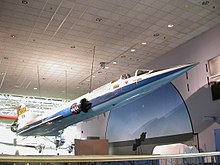

- XF-104
- This was the prototype aircraft; two examples were built and powered by Wright J65 engines (the J79 was not yet ready). The second prototype was equipped with the M61 cannon as an armament test bed. Both aircraft were destroyed in crashes.[210]
- YF-104A
- The YF-104A was a pre-production aircraft used for engine, equipment, and flight testing;[22] 17 were built, with the first flight taking place on 17 February 1956 and reaching Mach 2 for the first time on 27 April.[211]
- F-104A
- This aircraft was the initial production single-seat interceptor version, very similar to the YF-104A.[212] A total of 153 were built.[46] The F-104A was in USAF service from 1958 through 1960, then transferred to the Air National Guard until 1963. At that time they were recalled by the USAF Air Defense Command for the 319th and 331st Fighter Interceptor Squadrons. Some were released for export to Jordan, Pakistan, and Taiwan, each of which used it in combat. The 319th F-104As and Bs had their engines replaced in 1967 with the J79-GE-19, which provided 17,900 lbf (79.6 kN) of thrust in afterburner; the service ceiling with this engine was in excess of 73,000 ft (22,000 m). In 1969, all the F-104A/Bs in ADC service were retired. On 16 May 1958, an F-104A flown by USAF Captain Walter W. Irwin set a world flight airspeed record of 1,404.012 mph (2,259.538 km/h).[213]
- NF-104A
- The NF-104A was used for three demilitarized versions with an additional 6,000 lbf (27 kN) Rocketdyne LR121/AR-2-NA-1 rocket engine, used for astronaut training at altitudes up to 120,800 ft (36,800 m).[214]
- QF-104A
- A total of 24 F-104As (4 YF-104As, 20 early F-104As) were converted into radio-controlled drones and test aircraft. These target drones were able to be flown by onboard pilots as well as remotely controlled by pilots using radio-control equipment either on the ground or flying in other aircraft.[212]
- F-104B
- The F-104B was a tandem two-seat, dual-control
- F-104C
- A fighter-bomber for USAF Tactical Air Command, the F-104C had improved fire-control radar (AN/ASG-14T-2), one centerline and two pylons under each wing (for a total of five), and the ability to carry one Mk 28 or Mk 43 nuclear weapon on the centerline pylon. The F-104C also had in-flight refueling capability. Seventy-seven F-104Cs were built.[218] On 14 December 1959, an F-104C set a world altitude record of 103,389 ft (31,513 m).[219]
- F-104D
- The F-104D designation was a dual-control trainer version of the F-104C. Twenty-one examples were built.[46]
- F-104DJ
- This aircraft was a dual-control trainer version of the F-104J for the Taiwanese Air Force.[220]
- F-104F
- The F-104F designation was given to a dual-control trainer based on the F-104D, but using the upgraded engine of the F-104G. It had no radar, and was not combat-capable. The F-104F was produced as an interim trainer for the German Air Force. All 30 F-104F aircraft were retired by 1972.[221][222]

- F-104G
- The F-104G was the most-produced version of the F-104 family, a multi-role fighter-bomber with a total of 1,127 aircraft built. They were manufactured by Lockheed, as well as under license by Canadair and a consortium of European companies that included Messerschmitt/MBB, Fiat, Fokker, and SABCA. The type featured a strengthened fuselage, wing, and empennage structures; the larger vertical fin with fully powered rudder as used on the two-seat versions; fully powered brakes, a new anti-skid system, and larger tires; revised flaps for improved combat maneuvering; and a larger braking chute. Upgraded avionics included the Autonetics NASARR F15A-41B radar with air-to-air, ground-mapping, contour-mapping, and terrain-avoidance modes, as well as the Litton LN-3 inertial navigation system (the first on a production fighter).[223][224][225][226]

- RF-104G
- The RF-104G was a tactical reconnaissance model based on the F-104G,[46] usually with three KS-67A cameras mounted in the forward fuselage in place of the internal cannon. Many of the 189 built were subsequently reconfigured to the F-104G standard.[227]
- TF-104G
- A combat-capable trainer version of the F-104G,[46] the TF-104G had no cannon or centerline pylon, and reduced internal fuel.[228] One of the 220 aircraft produced was used by Lockheed as a demonstrator with the civil registration number N104L, and was flown by Jackie Cochran to set three women's world speed records in 1964. This aircraft later served in the Netherlands.[229] A pair of two-seat TF-104Gs joined the NASA Dryden inventory in July 1975 along with a Fokker-built former RF-104G.[230]
- F-104H
- The F-104H was a projected export version based on the F-104G with an optical gunsight and simplified equipment. It was canceled prior to construction.[231]
- F-104J
- The F-104J was a specialized interceptor version of the F-104G for the Japanese ASDF, built under license by Mitsubishi for the air-superiority role; it was armed with cannon and four Sidewinders, but had no strike capability. Some were converted to UF-104J radio-controlled target drones and destroyed. A total of 210 were built, three by Lockheed, 29 by Mitsubishi from Lockheed-sourced components, and 178 by Mitsubishi.[46][232] After being retired in Japan, the U.S. delivered some of these 104J/DJs to the air force of Taiwan.[220]
- F-104N
- Three unarmed and lighter F-104Gs were delivered to NASA in 1963 for use as high-speed chase aircraft and given the designation F-104N.[233][234] One, piloted by Joe Walker, collided with an XB-70 on 8 June 1966.[235]
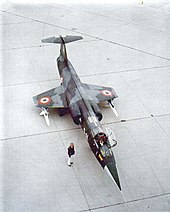
- F-104S




